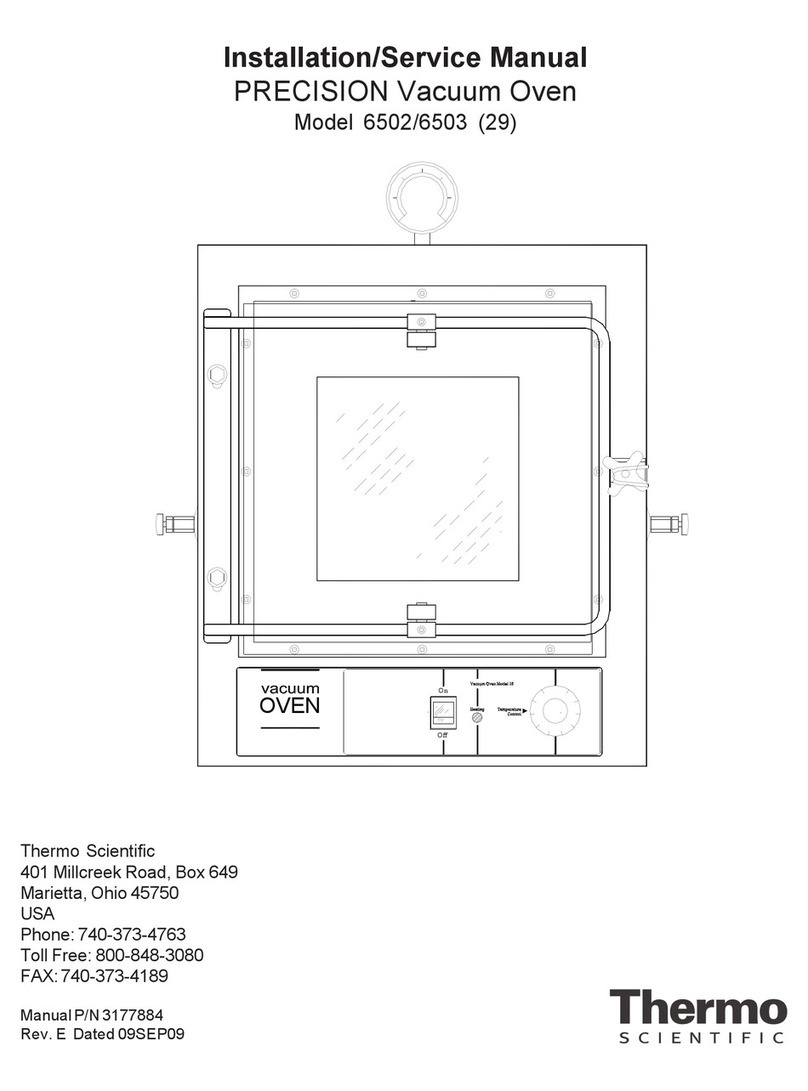
4
TEMPERATURE ADJUSTMENT
Apply power to the unit by pressing the power
switch to "On". Turn the Temp. Control knob fully
clockwise. The "Heating" indicator will glow when
theunit is heating. Whenthe temperature reaches
the desired operating level (as indicated on the
thermometer) turn the Temp. Control knob
counterclockwise until the "Heating" indicator just
turnsoff. Allow the temperaturetocycle on and off
severaltimes (3 to 4 hours) to makesure the oven
has stabilized. Adjust the Temp. Control knob up
or down as necessary.
Oven thermostats are set for operation at
temperatures over 100°C.
For control at lower temperatures, readjustment
of the thermostat may be necessary.
Two allen wrenches are required:
• 1/16" for the thermostat shaft
• 5/64" for the thermostat knob
1. Bring oven to room ambient.
2. Energize oven.
3. Set thermostat fully counter-clockwise (heat
lamp is on).
4. Remove thermostat knob. Note small allen
screw within shaft.
5. Turn shaft allen screw clockwise until lamp
goes out.
6. Attemptto control at the desiredtemperature.
7. It may be necessary to repeat this procedure.
NOTE
WHEN THE OVEN IS NEW AND IS FIRST HEATED,
THE INSULATION WILL BECOME SCORCHED AND
SOMESMOKEANDBURNING ODOR WILL OCCUR.
IT IS NORMAL FOR THIS CONDITION TO LAST 2
TO 3 HOURS AT HIGH HEAT.
VACUUM OPERATION
The following information serves as a guide to
operation of the vacuum system.
The total variable leak rate of the oven is 3 inches
of mercury per cubic foot per 24 hours at 29 to 26
inches of mercury.
Vacuum Sealing Agents
High vacuum silicone grease is often necessary
to provide a proper seal at tubing connections,
valve connections, door seals, etc. This is
especially important at high vacuums. However,
there are restrictions to using silicone grease,
depending upon the type of materials placed in
the oven. Refer to the maintenance section of this
manual for restrictions.
Out Gassing
Theoperationoftheovenathightemperaturewhile
evacuatingthechamberwillhelp driveoffabsorbed
gasses on the walls and other surfaces and
facilitate attainment of high vacuums.
Evacuating Chamber
Connect vacuum tubing to either hose connection
ontopof vacuumoven. Turnon thevacuum pump,
then open the valve on the oven. The vacuum
gaugewillindicate whenthe desiredpressurelevel
is obtained. Once obtained, close the valve, and
turn off the vacuum pump. Air may be bled into
thechamber through theunused valve to raisethe
pressure level.
NOTE
TO MAINTAIN AS LEAK PROOF A SYSTEM AS
POSSIBLE USE ONLY VACUUM PUMP TUBING.
MAKE SURE ALL CONNECTIONS ARE TIGHT. USE
A VACUUM PUMP SIZED TO ADEQUATELY
EVACUATE THE OVEN VOLUME.
CAUTION
VACUUM PUMPS SHOULD NEVER BE TURNED
OFF WHILE CONNECTED TO A SYSTEM UNDER
VACUUM. OIL BACK UP INTO THE LINES AND
SYSTEM WILL OCCUR NECESSITATING
EXTENSIVE CLEAN UP.
When turning vacuum pump off, immediately
undo the connection at the oven valve or the
pump intake.
1. Close the vacuum valve
2. Turn the pump off.
3. Immediately break the connection at the
pump or oven.
4. Leave connection open for one minute,
then reattach.






































